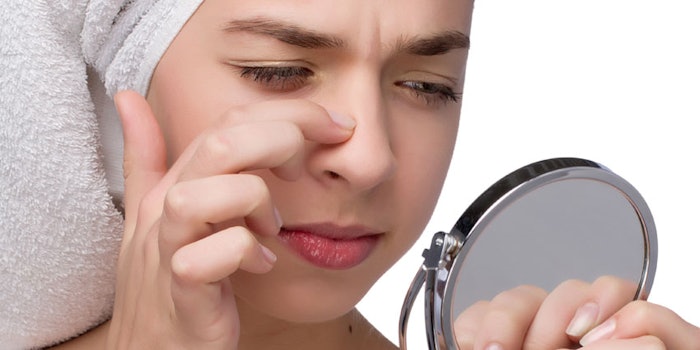
Pore size remains a significant concern for some, as evidenced by about 10% of this author’s clients—a group of British Caucasian women ages 30–60. Enlarged facial pores are the visible, topographic feature that corresponds to enlarged openings of pilosebaceous follicles. They appear either as empty funnels or filled with cornified cylindrical plugs, i.e., comedones.
Although facial pores are present in all people, their appearance differs among individuals and ethnicities.1 Enlarged facial pores are known to be a significant cosmetic concern in Asian women. One large Japanese survey estimated that more than half of women ages 20–30 complained of conspicuous pores.2 In general, pore appearance varies among the world’s ethnic groups, with differences in pore size, in the epidermal architecture around the pores, and among the follicles in the epidermis.3
Many factors contribute to enlarged facial pores. These include: environmental factors such as seasons, relative humidity and temperature; genetic predisposition; aging; skin type; chronic sun exposure (photoaging); and hormonal fluctuations. Some of these are discussed here.
Pores and Aging
Facial pores become more prominent with aging. The rate of sebum production actually declines with aging; however, enlarged pores do not appear to close. Rather, pores remain enlarged due to changes in the epidermal architecture.
In addition, some studies regard enlarged pores to be primarily a result of photoaging. While this is partly true, people with enlarged pores may not show some other signs of photoaging, such as sallow skin tone, hyperpigmentation, crepe paper-like skin texture and wrinkles.
Pores and Oily Skin
Most women in this author’s practice who report having enlarged facial pores can be categorized as having an oily skin type. Enlarged pores are an attribute of oily skin that can lead to negative self-perception and embarrassment. Women with oily skin report difficulty in applying makeup on the shiny, uneven skin surface. They also feel that the oiliness destroys the film-forming properties of skin care and decorative cosmetics, making foundations run and leading to uneven coverage.4 When creating skin care or makeup for a broad range of skin types, the formulator should consider this challenge for oily skin when selecting ingredients for the oil phase of the emulsion.
Pore Size and Menstrual Cycle
Pore sizes fluctuate with the menstrual cycle, increasing at ovulation.5 This increase follows the pattern of sebum production, governed by hormones (mainly androgens) but also affected by stress and diet, although the data remains inconclusive. Research has linked enlarged pores to sebum overproduction5 and increased serum level of Insulin-like Growth Factor-1 (IGF-1).6 The large hollow textures of conspicuous pores have been shown to correlate with a highly undulated epidermal-dermal junction around the pore’s opening7 with a presence of discontinuous dermal papillae and isotropic dermal fibers.8 The involvement of the IGF-1/IGFBP-3 signaling pathway and hyperkeratinization (increased expression of K16) are thought to contribute to the formation of conspicuous facial pores.9
Treatment of Pores
Key strategies for treating enlarged facial pores are to reduce the sebum overproduction and hyper-proliferation of follicular keratinocytes. Sebum overproduction is known to compromise the epidermal barrier function of the follicular wall, rendering it permeable to inflammatory substances that might facilitate the changes in epidermal architecture.
Adequate skin cleansing, peeling and exfoliation to remove excess sebum are an important part of a skin care routine for individuals having oily skin. However, over-cleansing skin can lead to a compromised barrier function and to the release of sebum from follicular ostia to the skin surface, making skin appear even more shiny and oily. Acid peels maintain their place in the market, having shown mixed efficacy. One efficacy study on glycolic acid peels, performed five times at two-week intervals, showed a reduction in the number of conspicuous facial pores by 34.6%.10
Consumers who have enlarged pores knowingly look for products that are non-comedogenic. However, many consumers choose products claiming to “reduce pore size,” often finding these products are ineffective. The look of pore size is best reduced by keeping the pores clean with peels and exfoliation.
Raw Material Technologies
Personal care ingredient technologies with specific pore tightening or minimizing claims include: a combination of Enantia chlorantha extract and oleoanolic acid from olive tree leavesa; a mixture of butylene glycol and Fomes officinalis extract containing agaric acidb; an oligosaccharide-rich extract of Lens esculentac; an enzyme-degraded soybean lecithin with 20–30% lysophosphatidic acid (LPA)d; and a mixture of mastic gum, lecithin and glycerin.e
Facial skin is heterogenic, and consumers increasingly expect personalized solutions. The adoption of these specialized technologies stems from clinical efficacy and appropriate application of the final skin care product.
References
- E Uhoda, Measurements of the dilated pores: Methods and Interests, Int J of Cosm Surg 5(3) 208 (2005)
- Y Katsuta, T Lida, S Inomata and S Yoshida, Improving the Appearance of Facial Pores, Cosm & Toil 119(10) 59 (2004)
- Y Sugiyama-Nakagiri , K Sugata, A Hachiya, O Osanai, A Ohuchi and T Kitahara, Ethnic differences in the structural properties of facial skin, J Dermatol Sci 53(2) 135-9 (2009)
- Robert Arbuckle et al, Patient experiences with oily skin: The qualitative development of content for two new patient reported outcome questionnaires, Health and Quality of Life Outcomes 6:80 (2008)
- M Roh, M Han, D Kim and K Chung, Sebum output as a factor contributing to the size of facial pores, Br J Dermatol 155(5) 890-4 (Nov 2006)
- Y Sugiyama-Nakagiri, A Naoe, A Ohuchi, T Kitahara, Serum levels of IGF-1 are related to human skin characteristics including the conspicuousness of facial pores, Int J Cosmet Sci 33(2) 144-9 (Apr 2011)
- K Sugata, T Nishijima, T Kitahara and Y Takema, Confocal laser microscopic imaging of conspicuous facial pores in vivo: Relation between the appearance and the internal structure of skin, Skin Res Technol 14(2) 208-12 (May 2008)
- K Mizukoshi and K Takahashi, Analysis of the skin surface and inner structure around pores on the face, Skin Res Technol 20(1) 23-9 (Feb 2014)
- Y Sugiyama-Nakagiri, A Ohuchi, A Hachiya and T Kitahara, Involvement of IGF-1/IGFBP-3 signaling on the conspicuousness of facial pores, Arch Dermatol Res 302(9) 661-7 (Nov 2010)
- N Kakudo et al, A novel method to measure conspicuous facial pores using computer analysis of digital-camera-captured images: the effect of glycolic acid chemical peeling, Skin Res 17(4) 427-33 (Nov 2011)










